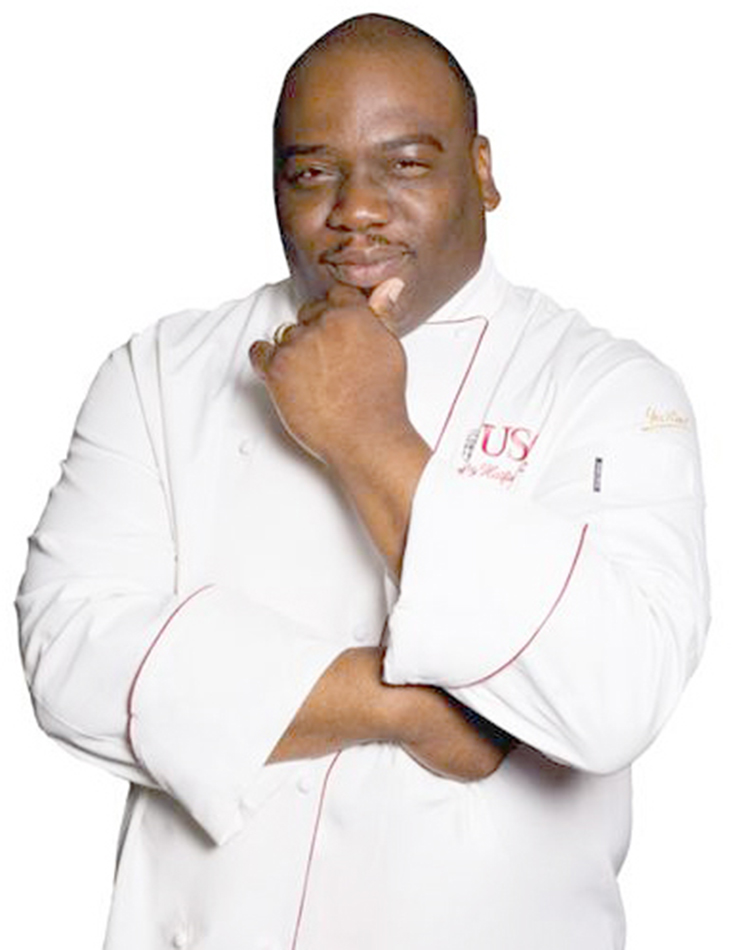USC Chef Mikery Hatfield turns ‘Cutthroat’

Cutthroat competitor · USC chef Mikery Hatfield competed on Food Network’s reality TV show Cutthroat Kitchen last Sunday. – Photo courtesy of USC News
It should come as no surprise that a chef would begin an interview by presenting a dish — and Chef Mikery Hatfield did not disappoint, bringing out fresh sesame and black pepper — crusted ahi tuna, seared rare, over Thai marinated vegetables and slices of grilled pineapple.
Hatfield described the components of the dish using words such as “vibrant” and “pop,” gesturing with his hands as he explained that the Thai vegetables add a subtle spiciness to the palate and that the decidedly “un-fishy” taste of the tuna indicates its freshness. Dipping a piece of tuna into Sriracha to “add a little bit of kick,” he added wistfully that he’ll be sad to see the dish leave the menu.
“But you know, everything comes to an end,” Hatfield said. “As a chef, you can’t rest on your laurels. We had a great run, it was a good dish, but we have a lot of regulars, and they get to the point where they say, ’What have you done for me lately?’”
Hatfield, who works as the head chef at McKay’s Restaurant at the Radisson Hotel, is no stranger to innovation. Over the summer, he unveiled a chicken and waffle burger and took home a seventh-place award from the Better Burger Project, a nationwide competition to incorporate mushrooms into a burger recipe. He’s constantly re-evaluating McKay’s menu, experimenting with new recipes and putting interesting twists on old favorites. And on Sunday, he made his debut on national television as a contestant on the Food Network reality cooking show Cutthroat Kitchen.
The show brings together four chefs who have to go through a series of challenges and are eliminated one by one. Each chef starts out with $25,000 to purchase items in an auction, which can be used to sabotage other chefs. However, at the end of the show, the last chef standing will walk away with only the money he or she has left over. Hatfield’s episode, “Electric Boo-Galoo,” was Halloween themed, which proved challenging when Hatfield was “sabotaged” and had to wear a Frankenstein mask, forcing him to prepare food on top of his head.
“I was like MacGyver,” Hatfield said. “I used one of the polished serving domes as a mirror in order to be able to see, and I put a sheet pan underneath me so anytime I cut something it would fall into the pan.”
Hatfield stressed that despite the comedic nature of the challenges on the show, his experience there was not too far from his real-life job as a chef.
“A day in the life of any chef is ‘figure it out’ because it’s never going to go the way you planned. I employed that type of ingenuity, and that’s how I was able to get it done,” Hatfield said. “You have to use a little ingenuity, a little MacGyver, a little prayer, whatever it takes.”
Though Hatfield was eliminated after the first round, he felt proud that he was able to create a product that stood on its own despite the challenges that he faced. Ultimately, he also felt grateful to have been able to interact with his competitors, who all supported each other off-camera despite their on-camera rivalry.
“We just got a good mix [of people],” Hatfield said. “Even during the interaction, everyone was cordial and friendly.”
At first, Hatfield was hesitant to participate, but when he finally got the casting call and went to the taping in January, he brought all of the skills he had amassed over a long culinary career. A Los Angeles native, Hatfield graduated from the culinary school at the Los Angeles Trade Technical College in 1998 and spent the next year and a half as an intern at the Century Plaza Hotel, preparing food for patrons from Bill Clinton to Ronald Reagan. He spent years at movie studios, from Sony Pictures to Warner Brothers, working his way up to the position of sous chef before taking his first executive sous chef job at Petco Stadium in San Diego, home of the San Diego Padres. Hatfield said coming to USC in 2011, however, was like “coming home” — even though getting here took a long journey.
“I’ve always wanted to work at ’SC, and I applied over the years several times, but I think more than ever that this was the perfect time [to start]. Because we’re all about the best USC experience, and I bring so many years of really specific experience with me now, that obviously I did not have years before when I applied to work at USC,” Hatfield.
Hatfield’s drive to innovate has been his most prominent quality since his first days in the industry. He still remembers, in an effort to master his craft, staying up all night baking cheesecakes in culinary school and distributing them to his neighbors because he ran out of room in his one-bedroom apartment.
“I said that if I’m going to be the chef that I want to be, there can’t be anything in the food service operation that I don’t know, that I don’t have the mastery of,” Hatfield said.
Today, that drive for constant improvement inspires him to craft his menu as a reflection of that excellence. But despite his position as head chef, he never forgets his audience.
“I called the dish ‘Tuna Thai’d,’” he said. “I try to make it fun. That’s the reaction I want when people sit down at my restaurant, like, ‘Oh, I get it.’ And then they see the plate and they go, ‘Wow.’”
